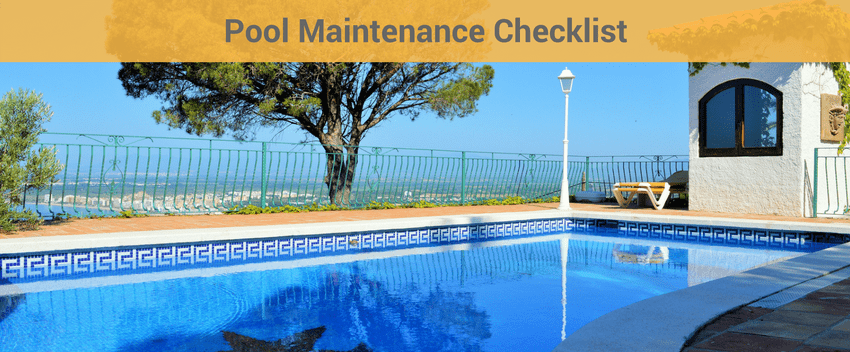
How can a person function well if he does not maintain himself by watching what he takes in and how he performs?
How can he function well if he is not taking medications when he feels part of his body is malfunctioning? The same applies to machines, and especially pool pump motors discussed in this post.
It’s simple; if you want your pool pump to keep functioning properly, you need to maintain it regularly. To reduce your maintenance expenses, as well as ensure optimum performance, you need a checklist; a list of maintenance actions you must be performing within various time frames.
We have compiled a number of these maintenance activities to be done daily, weekly, monthly and yearly.
Some special hardware that is used for the maintenance of swimming pool pumps includes vibrations analyzer to detect an unusual pattern of water movement and ultrasound analyzer to detect sound patterns and locate any issues with pumps or pipes. So, let’s roll with these maintenance practices.
Prior to a Functional Pool
Before we discuss the major maintenance practices of your pool pump per time frame, there are a few things you should ensure before your pool becomes fully functional with the pump.
- Clean and vacuum the empty pool painstakingly.
- Add water to your desired level or height at a recommended rate of 1” per hour.
- Run a test to determine the water balance, PH, hardness, and alkalinity.
- Inspect all the important components of your pool system.
- Lubricate mechanical joints and bearings.
- Inspect and clean tiles, skimmer, and grout with a cleanser.
- Seek the services of a pool water expert to analyze the water in your pool.
- It’s important to inspect and clean the pool deck.
- If necessary, you can also backwash the filter.
- Add algaecide in right proportions.
- Be sure that the skimmer and pump basket is empty.
Daily Maintenance Checklist
Here’s a list of some maintenance practices you should ensure daily to keep your pool pump in excellent condition.
- Always double check the speed of your water pump to be sure that it corresponds with the horsepower promised.
- Check for leaks, cracks or deterioration.
Weekly Maintenance Checklist
Weekly maintenance practices are highly necessary for the longevity of the pool pump. Some of these are:
- There might have been large deposits of debris at the bottom of the pool pump; remove these with a leaf scoop.
- Apply chlorine and any other required sanitizer. Also, test and adjust the sanitizer level.
- Ensure that the water is visibly clear and without contaminants. Clean the water if it’s not, and you can also get rid of floating leaves on the water surface.
- Test the PH level of water and ensure it’s at the recommended range of 7.3-7.7 depending on the material of your pool. Do not correct your PH more than once a week.
- Test and adjust the bromine (3-5 ppm recommended) and chlorine (1-3 ppm recommended) levels in the pool water.
- You also want to weekly test and adjust the Alkalinity, as well as the oxidizer and Stabilizer levels.
- Clean tiles at the water line.
- Only if required, you can backwash the filter pressure.
- Check water level and be sure it’s around the recommended rate of 1” (25mm) for every hour.
- You can also add a preventive dose of algaecide; only as necessary.
- According to label instructions, shock the pool to restore the sparkle of the pool water and destroy germs and other contaminants. This can be done fortnightly.
Monthly Maintenance Checklist
These practices should help you more in preventing damage or incurring unnecessary expenses. You can carry out the following monthly:
- According to specifications, check and repair seals, as well as lubricate bearings.
- Be sure that the pool pump motor is located securely on the base of the swimming pool.
- Adjust or fasten the losing couplings of the motor for excellent output and transfer operation.
- Test and adjust the calcium hardness of your pool as well as the dissolved solids. * Clean the filter chemically.
- Be sure that the total alkalinity of the pool is in the range of 120-150 ppm.
- Check all safety equipment like handrails to be sure that they are in excellent working conditions.
- In case you have a saltwater pool, check for the salt levels.
- It’s important to conduct the Langelier Saturation Index evaluation once a month.
- Inspect tiles, sealant, grout, and other exposed parts of the pool.
- For vinyl liner pools, check and repair holes and tears; while you want to look out for cracks in concrete, gunite, and fiberglass pools.
Annual Maintenance Checklist
- Inspect water pump to fine-tune, replace or repair bearings, drive belt, and any other parts that are malfunctioning.
- MInspect the vibration and temperature of the motor to ensure efficient functioning.
Even with all maintenance practices duly ensured, there’s still a chance that machines have a tendency to malfunction, and so does a pool pump. Early detection of an inefficient run of the pool pump can go a long way in preventing permanent damage and increased costs. You can generally detect and counter these problems when you start noticing decreased water flow, overheating of the pool pump, clogs, and usual noises. Call a technician as soon as you notice such signs before they escalate into bigger problems. The act of maintaining your pool pump regularly is a second to none act.



